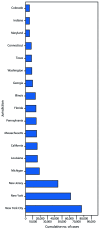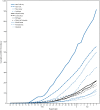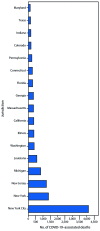Geographic Differences in COVID-19 Cases, Deaths, and Incidence - United States, February 12-April 7, 2020 - PubMed (original) (raw)
Geographic Differences in COVID-19 Cases, Deaths, and Incidence - United States, February 12-April 7, 2020
CDC COVID-19 Response Team. MMWR Morb Mortal Wkly Rep. 2020.
Abstract
Community transmission of coronavirus disease 2019 (COVID-19) was first detected in the United States in February 2020. By mid-March, all 50 states, the District of Columbia (DC), New York City (NYC), and four U.S. territories had reported cases of COVID-19. This report describes the geographic distribution of laboratory-confirmed COVID-19 cases and related deaths reported by each U.S. state, each territory and freely associated state,* DC, and NYC during February 12-April 7, 2020, and estimates cumulative incidence for each jurisdiction. In addition, it projects the jurisdiction-level trajectory of this pandemic by estimating case doubling times on April 7 and changes in cumulative incidence during the most recent 7-day period (March 31-April 7). As of April 7, 2020, a total of 395,926 cases of COVID-19, including 12,757 related deaths, were reported in the United States. Cumulative COVID-19 incidence varied substantially by jurisdiction, ranging from 20.6 cases per 100,000 in Minnesota to 915.3 in NYC. On April 7, national case doubling time was approximately 6.5 days, although this ranged from 5.5 to 8.0 days in the 10 jurisdictions reporting the most cases. Absolute change in cumulative incidence during March 31-April 7 also varied widely, ranging from an increase of 8.3 cases per 100,000 in Minnesota to 418.0 in NYC. Geographic differences in numbers of COVID-19 cases and deaths, cumulative incidence, and changes in incidence likely reflect a combination of jurisdiction-specific epidemiologic and population-level factors, including 1) the timing of COVID-19 introductions; 2) population density; 3) age distribution and prevalence of underlying medical conditions among COVID-19 patients (1-3); 4) the timing and extent of community mitigation measures; 5) diagnostic testing capacity; and 6) public health reporting practices. Monitoring jurisdiction-level numbers of COVID-19 cases, deaths, and changes in incidence is critical for understanding community risk and making decisions about community mitigation, including social distancing, and strategic health care resource allocation.
Figures
FIGURE 1
Cumulative number of reported COVID-19 cases, by jurisdiction — selected U.S. jurisdictions,,† April 7, 2020 Abbreviation: COVID-19 = coronavirus disease 2019 * Restricted to U.S. reporting jurisdictions with ≥5,000 COVID-19 cases reported as of April 7, 2020. † Data from New York are exclusive of New York City.
FIGURE 2
Cumulative incidence of COVID-19, by report date — selected U.S. jurisdictions,, March 10–April 7, 2020 Abbreviation: COVID-19 = coronavirus disease 2019. * Cases per 100,000 population. † Restricted to the 11 jurisdictions reporting the largest absolute increase in COVID-19 cumulative incidence during the most recent 7-day reporting period, March 31–April 7, 2020. § Data from New York are exclusive of New York City.
FIGURE 3
Number of reported COVID-19–related deaths, by jurisdiction — selected U.S. jurisdictions,,† April 7, 2020 Abbreviation: COVID-19 = coronavirus disease 2019. * Restricted to U.S. reporting jurisdictions with ≥5,000 COVID-19 cases reported as of April 7, 2020. † Data from New York are exclusive of New York City.
Similar articles
- Inverse correlation between average monthly high temperatures and COVID-19-related death rates in different geographical areas.
Benedetti F, Pachetti M, Marini B, Ippodrino R, Gallo RC, Ciccozzi M, Zella D. Benedetti F, et al. J Transl Med. 2020 Jun 23;18(1):251. doi: 10.1186/s12967-020-02418-5. J Transl Med. 2020. PMID: 32576227 Free PMC article. - Timing of Community Mitigation and Changes in Reported COVID-19 and Community Mobility - Four U.S. Metropolitan Areas, February 26-April 1, 2020.
Lasry A, Kidder D, Hast M, Poovey J, Sunshine G, Winglee K, Zviedrite N, Ahmed F, Ethier KA; CDC Public Health Law Program; New York City Department of Health and Mental Hygiene; Louisiana Department of Health; Public Health – Seattle & King County; San Francisco COVID-19 Response Team; Alameda County Public Health Department; San Mateo County Health Department; Marin County Division of Public Health. Lasry A, et al. MMWR Morb Mortal Wkly Rep. 2020 Apr 17;69(15):451-457. doi: 10.15585/mmwr.mm6915e2. MMWR Morb Mortal Wkly Rep. 2020. PMID: 32298245 Free PMC article. - Preliminary Estimate of Excess Mortality During the COVID-19 Outbreak - New York City, March 11-May 2, 2020.
New York City Department of Health and Mental Hygiene (DOHMH) COVID-19 Response Team. New York City Department of Health and Mental Hygiene (DOHMH) COVID-19 Response Team. MMWR Morb Mortal Wkly Rep. 2020 May 15;69(19):603-605. doi: 10.15585/mmwr.mm6919e5. MMWR Morb Mortal Wkly Rep. 2020. PMID: 32407306 - Epidemiology of the 2020 Pandemic of COVID-19 in the State of Texas: The First Month of Community Spread.
Khose S, Moore JX, Wang HE. Khose S, et al. J Community Health. 2020 Aug;45(4):696-701. doi: 10.1007/s10900-020-00854-4. J Community Health. 2020. PMID: 32500438 Free PMC article. Review. - Systematic Review of Clinical Insights into Novel Coronavirus (CoVID-19) Pandemic: Persisting Challenges in U.S. Rural Population.
Lakhani HV, Pillai SS, Zehra M, Sharma I, Sodhi K. Lakhani HV, et al. Int J Environ Res Public Health. 2020 Jun 15;17(12):4279. doi: 10.3390/ijerph17124279. Int J Environ Res Public Health. 2020. PMID: 32549334 Free PMC article.
Cited by
- Molecular and Immunological Diagnostic Tests of COVID-19: Current Status and Challenges.
Kilic T, Weissleder R, Lee H. Kilic T, et al. iScience. 2020 Aug 21;23(8):101406. doi: 10.1016/j.isci.2020.101406. Epub 2020 Jul 25. iScience. 2020. PMID: 32771976 Free PMC article. Review. - Population-based correlates of COVID-19 infection: An analysis from the DFW COVID-19 prevalence study.
Singal AG, Masica A, Esselink K, Murphy CC, Dever JA, Reczek A, Bensen M, Mack N, Stutts E, Ridenhour JL, Galt E, Brainerd J, Kopplin N, Yekkaluri S, Rubio C, Anderson S, Jan K, Whitworth N, Wagner J, Allen S, Muthukumar AR, Tiro J. Singal AG, et al. PLoS One. 2022 Dec 1;17(12):e0278335. doi: 10.1371/journal.pone.0278335. eCollection 2022. PLoS One. 2022. PMID: 36454745 Free PMC article. - ICU outcomes and survival in patients with severe COVID-19 in the largest health care system in central Florida.
Oliveira E, Parikh A, Lopez-Ruiz A, Carrilo M, Goldberg J, Cearras M, Fernainy K, Andersen S, Mercado L, Guan J, Zafar H, Louzon P, Carr A, Baloch N, Pratley R, Silverstry S, Hsu V, Sniffen J, Herrera V, Finkler N. Oliveira E, et al. PLoS One. 2021 Mar 25;16(3):e0249038. doi: 10.1371/journal.pone.0249038. eCollection 2021. PLoS One. 2021. PMID: 33765049 Free PMC article. - Ambient temperature and subsequent COVID-19 mortality in the OECD countries and individual United States.
Christophi CA, Sotos-Prieto M, Lan FY, Delgado-Velandia M, Efthymiou V, Gaviola GC, Hadjivasilis A, Hsu YT, Kyprianou A, Lidoriki I, Wei CF, Rodriguez-Artalejo F, Kales SN. Christophi CA, et al. Sci Rep. 2021 Apr 22;11(1):8710. doi: 10.1038/s41598-021-87803-w. Sci Rep. 2021. PMID: 33888744 Free PMC article. - Americans' perceptions of disparities in COVID-19 mortality: Results from a nationally-representative survey.
Gollust SE, Vogel RI, Rothman A, Yzer M, Fowler EF, Nagler RH. Gollust SE, et al. Prev Med. 2020 Dec;141:106278. doi: 10.1016/j.ypmed.2020.106278. Epub 2020 Oct 4. Prev Med. 2020. PMID: 33027615 Free PMC article.
References
- McMichael TM, Clark S, Pogosjans S, et al.; Public Health – Seattle & King County; EvergreenHealth; CDC COVID-19 Investigation Team. COVID-19 in a long-term care facility—King County, Washington, February 27–March 9, 2020. MMWR Morb Mortal Wkly Rep 2020;69:339–42. 10.15585/mmwr.mm6912e1 - DOI - PMC - PubMed
MeSH terms
LinkOut - more resources
Full Text Sources
Research Materials
Miscellaneous


